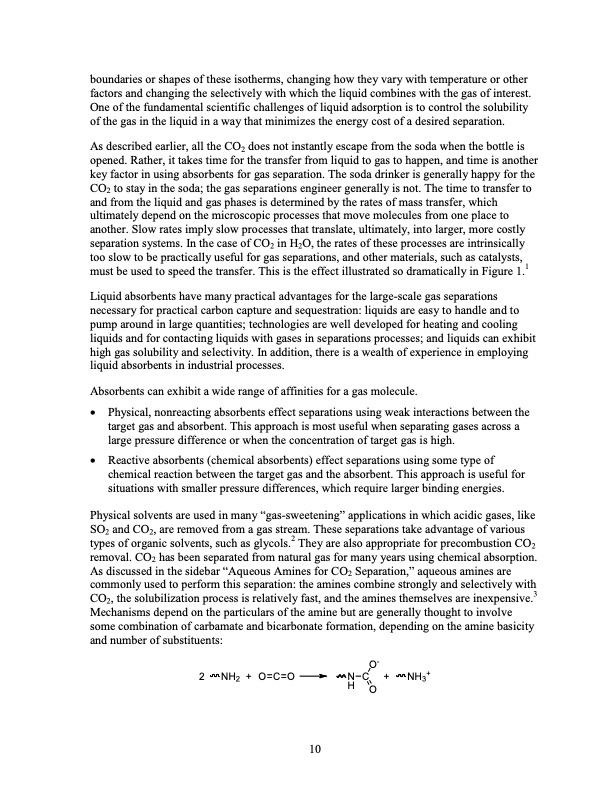
PDF Publication Title:
Text from PDF Page: 024
boundaries or shapes of these isotherms, changing how they vary with temperature or other factors and changing the selectively with which the liquid combines with the gas of interest. One of the fundamental scientific challenges of liquid adsorption is to control the solubility of the gas in the liquid in a way that minimizes the energy cost of a desired separation. As described earlier, all the CO2 does not instantly escape from the soda when the bottle is opened. Rather, it takes time for the transfer from liquid to gas to happen, and time is another key factor in using absorbents for gas separation. The soda drinker is generally happy for the CO2 to stay in the soda; the gas separations engineer generally is not. The time to transfer to and from the liquid and gas phases is determined by the rates of mass transfer, which ultimately depend on the microscopic processes that move molecules from one place to another. Slow rates imply slow processes that translate, ultimately, into larger, more costly separation systems. In the case of CO2 in H2O, the rates of these processes are intrinsically too slow to be practically useful for gas separations, and other materials, such as catalysts, 1 must be used to speed the transfer. This is the effect illustrated so dramatically in Figure 1. Liquid absorbents have many practical advantages for the large-scale gas separations necessary for practical carbon capture and sequestration: liquids are easy to handle and to pump around in large quantities; technologies are well developed for heating and cooling liquids and for contacting liquids with gases in separations processes; and liquids can exhibit high gas solubility and selectivity. In addition, there is a wealth of experience in employing liquid absorbents in industrial processes. Absorbents can exhibit a wide range of affinities for a gas molecule. • Physical, nonreacting absorbents effect separations using weak interactions between the target gas and absorbent. This approach is most useful when separating gases across a large pressure difference or when the concentration of target gas is high. • Reactive absorbents (chemical absorbents) effect separations using some type of chemical reaction between the target gas and the absorbent. This approach is useful for situations with smaller pressure differences, which require larger binding energies. Physical solvents are used in many “gas-sweetening” applications in which acidic gases, like SO2 and CO2, are removed from a gas stream. These separations take advantage of various types of organic solvents, such as glycols.2 They are also appropriate for precombustion CO2 removal. CO2 has been separated from natural gas for many years using chemical absorption. As discussed in the sidebar “Aqueous Amines for CO2 Separation,” aqueous amines are commonly used to perform this separation: the amines combine strongly and selectively with CO2, the solubilization process is relatively fast, and the amines themselves are inexpensive.3 Mechanisms depend on the particulars of the amine but are generally thought to involve some combination of carbamate and bicarbonate formation, depending on the amine basicity and number of substituents: 2 N H 2 + O C O O- NH C O + N H 3 + 10PDF Image | 2020 Carbon Capture

PDF Search Title:
2020 Carbon CaptureOriginal File Name Searched:
1291240.pdfDIY PDF Search: Google It | Yahoo | Bing
NFT (Non Fungible Token): Buy our tech, design, development or system NFT and become part of our tech NFT network... More Info
IT XR Project Redstone NFT Available for Sale: NFT for high tech turbine design with one part 3D printed counter-rotating energy turbine. Be part of the future with this NFT. Can be bought and sold but only one design NFT exists. Royalties go to the developer (Infinity) to keep enhancing design and applications... More Info
Infinity Turbine IT XR Project Redstone Design: NFT for sale... NFT for high tech turbine design with one part 3D printed counter-rotating energy turbine. Includes all rights to this turbine design, including license for Fluid Handling Block I and II for the turbine assembly and housing. The NFT includes the blueprints (cad/cam), revenue streams, and all future development of the IT XR Project Redstone... More Info
Infinity Turbine ROT Radial Outflow Turbine 24 Design and Worldwide Rights: NFT for sale... NFT for the ROT 24 energy turbine. Be part of the future with this NFT. This design can be bought and sold but only one design NFT exists. You may manufacture the unit, or get the revenues from its sale from Infinity Turbine. Royalties go to the developer (Infinity) to keep enhancing design and applications... More Info
Infinity Supercritical CO2 10 Liter Extractor Design and Worldwide Rights: The Infinity Supercritical 10L CO2 extractor is for botanical oil extraction, which is rich in terpenes and can produce shelf ready full spectrum oil. With over 5 years of development, this industry leader mature extractor machine has been sold since 2015 and is part of many profitable businesses. The process can also be used for electrowinning, e-waste recycling, and lithium battery recycling, gold mining electronic wastes, precious metals. CO2 can also be used in a reverse fuel cell with nafion to make a gas-to-liquids fuel, such as methanol, ethanol and butanol or ethylene. Supercritical CO2 has also been used for treating nafion to make it more effective catalyst. This NFT is for the purchase of worldwide rights which includes the design. More Info
NFT (Non Fungible Token): Buy our tech, design, development or system NFT and become part of our tech NFT network... More Info
Infinity Turbine Products: Special for this month, any plans are $10,000 for complete Cad/Cam blueprints. License is for one build. Try before you buy a production license. May pay by Bitcoin or other Crypto. Products Page... More Info
| CONTACT TEL: 608-238-6001 Email: greg@infinityturbine.com | RSS | AMP |